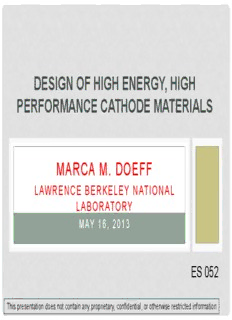
Design of High Performance, High Energy Cathode Materials PDF
Preview Design of High Performance, High Energy Cathode Materials
DESIGN OF HIGH ENERGY, HIGH PERFORMANCE CATHODE MATERIALS M ARCA M . DOEFF LAWRE NCE BERKELEY NATIONA L LA B ORATORY MAY 16, 2013 ES 052 This presentation does not contain any proprietary, confidential, or otherwise restricted information Overview Timeline Barriers • Project start date-10/1/2011 • Barriers addressed • Project end date- 9/30/2015 • Energy Density • 40% complete • Cost • Cycle Life Budget • Total project funding – DOE share $475k/yr ($1900k Partners total) • Interactions/ collaborations • Funding received in FY12 • LBNL, SSRL, UCB $475k • Project lead=LBNL • Funding for FY13 • $475k 2 RELEVANCE/OBJECTIVES • Develop high energy, high performance cathode materials that cost less • Partial Ti-substitution of NMCs to reduce first cycle inefficiencies and obtain higher practical discharge capacities • Spray pyrolysis and related techniques to produce coated and composite materials containing high voltage electrode materials • Example: LiFePO @LiNi Mn O 4 0.5 1.5 4 1um 3 MILESTONES Milestone Due date Status/Comments Composites consisting of spray- 9/13 On track. Will consider pyrolyzed LNMS hollow particles LiMnPO as an 4 containing and coated with LiFePO alternative, less reactive, 4 or a manganese oxide spinel will be coating. synthesized and electrochemically characterized. Thin film electrodes of a high energy Ti- 9/13 Particulate electrodes substituted NMC suitable for with no binder/carbon synchrotron studies will be produced may be suitable for and electrochemically characterized. synchrotron studies. Replace milestone. 4 TECHNICAL APPROACH SPRAY PYROLYSIS Solid-particle formation high e concentration 10µm m 700ºC i T 120 kHz e c bursting n 10µm 1µm e d 1M metal si Intraparticle e nitrates in reaction R porous/ DI H O 2 hollow T T = surface tension dh =0.73 3 ρf 2 ρ = density of solution porous a = frequency f a Control of particle size Solid particle bimodal Morphology control Coat/fill particles via choice of precursors (one step) and postprocessing (two steps) 5 TECHNICAL APPROACH HIGH CAPACITY NMCS • Synthesize substituted NMCs • Coprecipitation • Combustion synthesis • Spray pyrolysis (planned, not yet carried out) • Characterize • Electrochemical (half cells) • Conventional physical methods • Synchrotron methods • Goal is higher capacity without sacrificing stability, safety TECHNICAL ACCOMPLISHMENTS/TYPICAL VOLTAGE CHARACTERISTICS OF NMCS Li/NMC-333 cell Li/NMC-442 cell • 1st cycle inefficiency observed even with low charge voltage limits • Half cell cycling with 4.3V charge limit is stable • Typical capacity is ~160 mAh/g NMC-333=Li[Ni Mn Co ]O ; NMC-442=Li[Ni Mn Co ]O 1/3 1/3 1/3 2 0.4 0.4 0.2 2 TECHNICAL ACCOMPLISHMENTS/CYCLING OF NMCS TO HIGHER POTENTIALS Li/NMC-333 cells • Higher capacity in half cells can be obtained by cycling to higher voltage limits • This results in a rapid capacity fade • Nanoparticulate electrode materials perform worse than conventional ones From “Electrode Materials for Lithium Ion Batteries” Kinson C. Kam and Marca M. Doeff, Materials Matters, Aldrich Materials Science, 7(4), 56 (2012). TECHNICAL ACCOMPLISHMENTS/NMC AND TI- SUBSTITUTED NMC VOLTAGE PROFILES-4.3-2.0V Li/NMC cells, 0.1 mA/cm2, 4.3-2.0V •Ti contents below ~4% improve discharge GNC=glycine-nitrate capacities combustion •Best results 170 mAh/g COH=coprecipitation (baseline materials=150-160 mAh/g) •Ti contents above ~4% have neutral or negative effect •Better first cycle efficiencies when Ti<~4% but not when Ti>4% From “Electrochemical and Physical Properties of Ti-substituted Layered Nickel Manganese Cobalt Oxide (NMC) Cathode Materials” Kinson C. Kam, Apurva Mehta, John T. Heron, and Marca M. Doeff, J. Electrochem. Soc. 159, A1383 (2012).
Description: